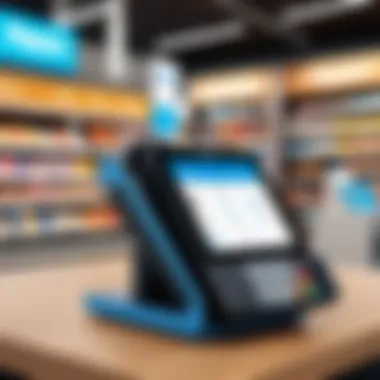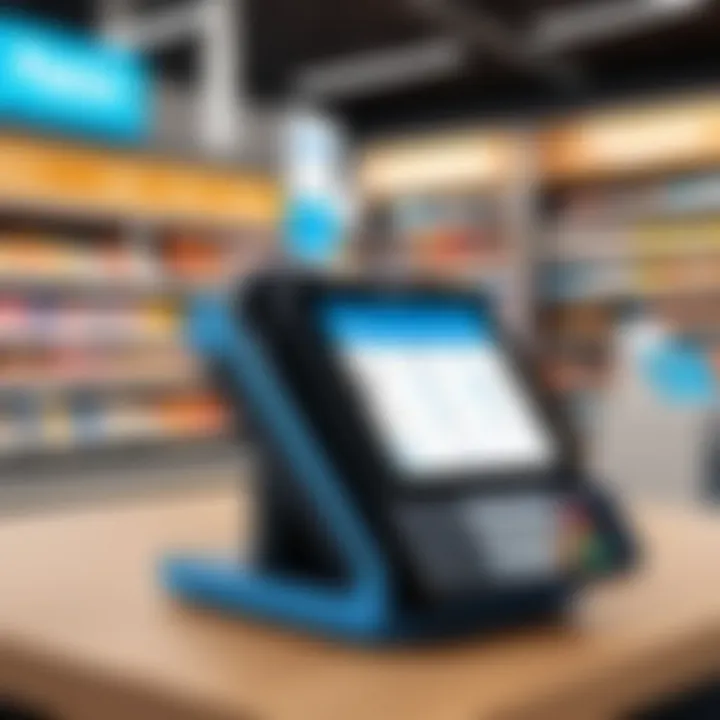Exploring Paytm POS: Features and Advantages for Businesses


Intro
In a rapidly evolving business environment, having the right tools to manage transactions effectively is crucial. Paytm POS stands out among the myriad of point-of-sale solutions available today. This system is not merely a cash register but a robust platform that combines technology and convenience. It has been gaining traction, especially among small and medium enterprises, due to its flexible features and user-friendly interface.
Modern commerce requires businesses to adapt to changing customer expectations and technological advancements. Paytm POS offers an avenue for businesses to refine their operations while enriching customer experience. By integrating various functionalities like payment processing, inventory management, and customer relationship management into one seamless solution, it positions itself as a pivotal instrument in today's commercial landscape.
Through this comprehensive overview, we will explore the key characteristics, technological underpinnings, and advantages of Paytm POS. We will also discuss how this system fares against traditional POS solutions, providing insights for savvy business owners navigating complex decision-making processes in harnessing technology for growth.
Preamble to Paytm POS
Understanding Paytm POS is more than just a cursory glance at another financial tool. In the modern landscape of commerce, where digital transformation has become integral, solutions like Paytm POS present themselves as pivotal players. Businesses today are not just looking for simple transaction processes; they want systems that are integrated, efficient, and capable of bringing in data that helps in decision-making.
The Evolution of Payment Solutions
Over the years, the payment solutions space has undergone a remarkable transformation, evolving from traditional cash registers to sophisticated digital platforms. Back when people relied solely on cash and checks, the concept of handling payments involved a lot of manual labor and high risks. Then came credit and debit cards, which were a game changer for transaction efficiency.
The advent of mobile wallets marked another significant milestone. Here, the likes of Paytm, PhonePe, and Google Pay began to disrupt the market, promoting simpler payment processes through smartphones. Transactions could happen in the blink of an eye, eliminating the drawbacks of cash—like theft or returning change. This shift brought about a faster pace of life for consumers and a myriad of opportunities for businesses.
With the integration of payment solutions into Point-of-Sale systems, companies now have tools that do more than just process payments. They analyze customer data, manage inventory, and even help in exceeding customer service expectations.
As technology continues to blend seamlessly with daily transactions, its evolution is not simply about speed; it’s about creating meaningful connections between businesses and their customers. Knowing where we started and where we're headed is critical for grasping the relevance of tools like Paytm's POS within this broader spectrum.
Paytm's Journey in the Digital Payment Space
When Paytm launched, it was largely perceived as just another digital wallet. Today, it has diversified to become a full-fledged ecosystem in the digital payment arena. Founded in 2010, the platform initially catered to mobile recharge and bill payments. Just two years later, the company allowed users to pay at retail merchants, venturing into the world of e-commerce and digital transactions like a fish takes to water.
What sets Paytm apart is its conscientious approach to user needs. The company has consistently been at the forefront of technology adoption, providing features that many users had not yet encountered. For example, the introduction of QR codes helped small businesses bypass the need for card machines, thus making digital payments accessible to a wider audience.
Paytm's enterprising spirit is embodied in its solution offerings, which keep enhancing with features tailored for varied business needs. From launching the Paytm POS system that consolidates multiple payment methods to being a pioneer in Paytm Payments Bank, its journey reflects adaptability and futuristic vision.
Moreover, as news about digital transactions has spread like wildfire, Paytm has embraced the rapid changes, continually updating its systems to accommodate newer forms of payments, such as UPI transactions. It’s this kind of progression that has cemented Paytm’s presence in the digital payment landscape, making it a household name in India—where cashless transactions are quickly becoming the norm.
"The ability to evolve with emerging trends is what defines the longevity of a payment solution in the marketplace."
In sum, the importance of Paytm POS is deeply intertwined with how far the user journey has come in the digital payment realm. As we delve deeper into its functionalities, we gain insight into how it shapes businesses and consumer behavior in this technology-driven age.
Understanding Point-of-Sale Systems
Point-of-sale systems have undergone a dramatic transformation in recent years, transitioning from simple cash registers to sophisticated technology suites that streamline not just payment processes, but entire business operations. This section aims to delve into these systems, putting the spotlight on their significance within the larger context of commerce, particularly as we explore Paytm POS.
Understanding point-of-sale systems is crucial because they serve as the nexus where customer engagement meets transactional strategy. They are vital for businesses aiming to enhance efficiency, analyze sales trends, and improve customer satisfaction. As payment methods evolve and consumer expectations shift, businesses must adapt their systems to remain competitive. Therefore, grasping what a modern POS entails and how it functions can empower businesses to make informed decisions about their operational strategies.
Defining POS: Beyond the Cash Register
Gone are the days when the term "point-of-sale" conjured up images of a basic cash register where transactions were recorded and change handed out. Today’s POS systems represent advanced ecosystems combining payment collection, inventory management, and customer relationship management into a singular workflow.
At their core, POS systems handle sales transactions, but they also do much more:
- Inventory Management: These systems track stock levels in real-time and generate alerts when items run low.
- Customer Insights: They gather data about customer preferences and buying habits, enabling businesses to tailor marketing efforts.
- Reporting: They compile sales data into reports that aid in financial decision-making and performance assessments.


In essence, a modern POS system acts as a comprehensive tool that manages several back-office functions, thus transforming how businesses operate at their frontline.
The Role of Technology in Modern POS Systems
Technology stands as the bedrock upon which modern POS systems are built. From cloud computing to mobile applications, advancements in tech have radically redefined what POS solutions can do.
For one, cloud-based systems allow businesses to operate from anywhere, as long as they have an internet connection. This flexibility is crucial for retailers with multiple locations or those who attend events outside their usual environment, such as food festivals or markets.
Additionally, mobile POS (mPOS) solutions enable staff to take orders and process payments on-the-go, enhancing customer interaction. Imagine a scenario where a server takes your order from a tablet right at your table, or a vendor accepts payments via smartphone at a street fair. This technology enriches customers’ experiences by reducing wait times and streamlining service.
Another critical element is security. With an uptick in digital transactions, the technology integrated into POS systems prioritizes secure transaction processing, encrypting data to protect sensitive information. Keeping customer data safe isn’t just a regulatory requirement; it's a competitive advantage.
"The evolution of POS technology is not merely about convenience; it’s a shift towards creating more personalized and engaging customer experiences."
Thus, as we venture deeper into the realm of Paytm POS, appreciating the framework and functionality of point-of-sale systems offers valuable context for understanding how this tool can be leveraged effectively in today's digital commerce landscape.
Key Features of Paytm POS
The landscape of payment systems has shifted significantly, and Paytm POS stands at the forefront of that change. Understanding its key features is crucial for businesses looking to adapt to today’s fast-paced retail environment. Each element is carefully crafted not just to facilitate transactions but to enhance the overall business-customer interaction. Here, we will explore some of the standout features associated with Paytm POS, delving into why they matter.
User-Friendly Interface
A major selling point of Paytm POS is its user-friendly interface. Business owners know they can't afford to waste time on complicated systems that require extensive training. With a clean layout and intuitive design, Paytm POS allows even the least tech-savvy individuals to manage their operations efficiently. The buttons are logically placed, making navigation a breeze. Simplicity goes a long way. By eliminating unnecessary complexities, businesses can focus more on their core activities and less on the technology itself. This not only saves time but also reduces the likelihood oferrors during busy hours. For a shopkeeper or a restaurant owner, being able to complete a sale smoothly and swiftly can make all the difference.
Integration with Paytm Ecosystem
Another strong feature is how seamlessly Paytm POS integrates with the broader Paytm ecosystem. This interconnected nature means that businesses can benefit from a wide range of services—from payment processing to inventory management—all within one platform. Take for instance, a small cafe that uses Paytm POS; it can easily access analytics on customer preferences, track stock levels in real-time, and streamline invoices. This allows for more informed decision-making, whether they are considering adding a new item to their menu or planning a promotional campaign. It’s like having a digital assistant, handling multiple tasks in the background while the business can focus on service and growth.
Real-Time Analytics and Reporting
Real-time analytics and reporting stand out as critical capabilities within Paytm POS. Business or shop owners crave insights into their operations, and this system provides exactly that. Imagine a retail store manager who can check sales data instantly from their smartphone; they are empowered to make quick adjustments based on up-to-the-minute trends. Features such as sales tracking, customer behavior analysis, and financial overview help owners understand their market better. By acting on this data promptly, businesses are better positioned to seize opportunities or cushion against downturns. It's about turning numbers into actionable insights, something every entrepreneur appreciates.
Multi-Channel Payment Acceptance
In a world where customers have various preferences for how they pay, the multi-channel payment acceptance feature of Paytm POS is a game changer. No longer do customers need to worry about whether they can use their preferred payment method; whether it’s QR codes, traditional card swipes, or digital wallets, Paytm POS accommodates them all. This versatility ensures that businesses don’t alienate potential customers. For example, at a bustling market, a vendor can cater to everyone, whether they're using cash, cards, or mobile payments. It's not just convenience; it’s crucial for capturing a broader customer base. This adaptability enables businesses to thrive in diverse environments, cementing customer loyalty in the process.
"Adaptability in payment methods can be the difference between a sale and a missed opportunity."
In wrapping up this section, it's clear that the key features of Paytm POS are designed not just for immediate efficiency, but for long-term strategic growth. The ease of use, integration capabilities, reporting tools, and payment flexibility create a robust system that speaks to the needs of modern businesses. In the following sections, we will further explore the advantages and challenge this platform presents in the broader context of point-of-sale systems.
Advantages of Using Paytm POS
Paytm POS is more than just a fancy gadget for processing payments; it’s a game changer for businesses navigating the ever-evolving landscape of commerce. As customers increasingly expect seamless transactions, integrating a robust POS system like Paytm’s can not only improve efficiency but also significantly enhance competitiveness in the market. Let’s look closer at why adopting Paytm POS makes sense for businesses.
Cost Efficiency for Businesses
One of the first benefits that jump out when you consider Paytm POS is its cost-effectiveness. Traditional POS systems often come with hefty price tags, both in terms of upfront costs and ongoing maintenance fees. Paytm POS takes a different approach. It offers relatively low initial investment requirements, making it accessible for small and medium-sized enterprises.
Additionally, the transaction fees associated with Paytm POS are quite competitive, often lower than those charged by banks for conventional merchant services. This translates to more money staying in your pocket, which can be a lifesaver for businesses that operate on thin margins.
Also noteworthy is how Paytm POS minimizes the need for additional hardware. Since it supports mobile devices, merchants can do away with bulky cash registers and dedicated terminals. A smartphone, tablet, or even a basic laptop can transform into a payment processor, thus reducing the financial burden of hardware purchases.


Enhanced Customer Experience
In today's market, the customer experience can make or break a business. With Paytm POS, you’re equipped with tools that help improve customer interactions. Its simple, user-friendly interface means that staff can get up to speed quickly, leading to shorter wait times during transactions. Customers appreciate quick and efficient service, and this system delivers just that.
Moreover, the option for multiple payment methods—ranging from cards to QR code scanning—is a huge win for customer convenience. No longer do patrons have to worry if their preferred payment method is accepted; with Paytm POS, they can pay in a manner that suits them best. This flexibility can result in increased sales, as customers are more likely to complete a purchase when they can pay how they like.
As an added bonus, Paytm POS comes with insights into sales trends. Understanding what’s selling and when allows businesses to tailor their offerings to consumer preferences, which ultimately enhances overall customer satisfaction. It's like having a crystal ball for your inventory needs, helping you to stock up on what matters most to your buyers.
Flexibility in Operations
Last but not least, Paytm POS introduces a level of operational flexibility that traditional systems often fail to provide. Businesses can manage their sales from different locations and channels without the need to be physically present at a specific spot. This means whether you are a food truck at a festival or a boutique in a busy shopping district, you can sell your products from anywhere.
Additionally, the app’s integration with inventory management features allows for seamless tracking. With all these functionalities combined, businesses can adapt quickly to changing conditions—be it a sudden spike in foot traffic during an event or a seasonal slowdown.
In essence, Paytm POS is designed to keep pace with the fast-moving nature of commerce today. By adopting this system, businesses are not just investing in a payment processor, but in a tool that can expand their operational capabilities and expand their horizons.
"Paytm POS isn’t just a payment solution; it's a vital component in modern business strategy, delivering efficiency and foresight".
In summary, the advantages of using Paytm POS as discussed above extend beyond mere transactions. Its cost efficiency, capacity to enhance customer experience, and flexibility in operations make it a preferred choice for numerous businesses in today’s competitive market.
Challenges and Considerations
Navigating the evolving landscape of payment solutions can be a bumpy road. While Paytm POS offers numerous advantages, it's crucial to understand the challenges and considerations that may come with its implementation. Not every business operates the same way, and that’s where the rubber meets the road.
Technical Challenges
One of the most salient hurdles that businesses might face when integrating Paytm POS is technical complexity. Setting up a new point-of-sale system isn’t always a walk in the park.
- System Compatibility: Existing hardware and software might pose issues. For instance, businesses using older physical terminals may find it hard to upgrade to Paytm's more advanced system. It can feel a bit like trying to fit a square peg in a round hole.
- Connectivity Issues: The system often relies on stable internet connectivity. In regions where the internet is unreliable, transactions could fail, frustrating both staff and customers.
- Training Staff: Getting the employees up to speed can be a daunting task. Depending on their tech-savviness, some may struggle with the new interfaces, wasting precious hours that could be better spent serving customers.
"The transition to a new POS system can feel overwhelming, but understanding these challenges upfront helps businesses prepare better."
Adoption Barriers for Small Businesses
Small businesses often find themselves in a tight spot when it comes to adopting new technologies. Paytm POS, while beneficial, still presents some roadblocks for these enterprises.
- Cost Concerns: Initial investments can be a sticking point. Even if the long-term savings are apparent, small businesses often operate on tight budgets. The thought of upfront costs can make them hesitant to dive into the latest tech.
- Fear of Change: Small business owners may have a strong attachment to their current systems. Change can be likened to jumping into the deep end without knowing how to swim. This hesitation can lead to missed opportunities for growth and efficiency.
- Regulatory Compliance: Complying with local laws regarding data security and customer privacy can add another layer of complexity. Navigating these requirements can be a considerable burden for smaller enterprises with limited resources.
Adapting to the challenges of Paytm POS is not a walk in the park, but it's far from impossible. With a willing mindset and proper preparation, businesses can overcome these hurdles and enjoy the multitude of benefits that a streamlined payment processing system has to offer.
Comparative Analysis of Paytm POS and Traditional POS Systems
When it comes to payment processing, the landscape is evolving faster than a speeding bullet. Traditional point-of-sale systems, while having their own charm, face stiff competition from tech-forward solutions like Paytm POS. Understanding the contrasts between these two is not just a matter of preference; it's about empowering businesses to make informed decisions that can influence their bottom line.
Functional Differences
Functionalities are the backbone of any POS system, shaping how businesses operate day to day. Traditional POS systems often rely on hardware-heavy setups. This typically means bulky cash registers, clunky barcode scanners, and despite their robustness, these systems can feel like they’re stuck in the past.
In contrast, Paytm POS leans heavily on cloud technology. Imagine running your operations from a lightweight tablet or smartphone. With features like:


- Inventory Management: Keep track of stock levels and receive alerts for low stock in real time.
- Sales Tracking: Pull sales reports and metrics without the headache of aggregating data from different sources.
- Integration: It smoothly connects with other components of the Paytm ecosystem, ensuring all financial transactions sync effortlessly.
This flexibility allows retailers to adapt to changing market needs swiftly, a feature traditional systems struggle to keep pace with.
"In today's world, the ability to adapt and respond quickly can often mean the difference between success and failure in retail."
Cost Comparison
Cost considerations weigh heavily on any business owner’s mind. Traditional POS systems typically require an upfront investment in hardware and software, along with ongoing maintenance costs. This means budgeting for unforeseen repairs, updates, and in many cases, subscription fees for software licenses.
Paytm POS flips this narrative. With lower initial setup costs, businesses can get started without digging too deep into their pockets. The ongoing fees are often more predictable and manageable, leading to better cash flow. Here are some factors in the cost equation:
- Upfront Costs: Hardware-dependent systems can cost thousands in purchase and installation. Meanwhile, Paytm POS’s mobile-first approach allows for immediate activation without hefty hardware investments.
- Transaction Fees: Both systems typically charge per transaction, but Paytm often offers transparent pricing structures, which eases the unpredictability that traditional systems can bring.
- Maintenance: Old-fashioned systems may incur repair costs as they age, while a heavily software-driven model like Paytm POS usually includes customer support and regular updates as part of the package.
Ultimately, the return on investment could significantly tip in favor of Paytm POS, especially for new businesses or those looking to modernize their approach to payments.
Future Prospects of Paytm POS
The future of Paytm POS is not just about surviving in a fast-paced digital marketplace; it’s about thriving amidst all the changes. The advent of technology is reshaping how businesses operate, and Paytm POS is at the forefront of this transformation. Understanding the trajectory of this platform sheds light on its potential to evolve and adapt in a rapidly changing environment, offering significant benefits to both merchants and customers alike.
Integration with Emerging Technologies
The integration of emerging technologies like artificial intelligence, machine learning, and blockchain could revolutionize Paytm POS systems. Picture an intelligent system that learns from user interactions and sales data, providing businesses with insights that inform decision making.
- AI-Powered Analytics: With AI, Paytm POS can offer predictive insights, forecasting sales trends, and helping businesses better manage inventory. Imagine knowing what your customers are inclined to buy even before they do. Such features can lead merchants to tailor their offerings or adjust prices dynamically.
- Blockchain for Security: To elevate trust, integrating blockchain technology can ensure secure transactions. Not only does this increase transparency, but it also provides a solid layer of protection against fraud. In a digital age where cybersecurity is a top concern, this could become a significant selling point.
- Internet of Things (IoT): Imagine smart devices communicating with Paytm POS for real-time insights into customer preferences and behaviors. This capability could bring personalization to a whole new level, enhancing customer engagement and satisfaction.
Implementing these technologies doesn't just boost efficiency; it allows businesses to make informed choices grounded in data-driven insights, truly making Paytm POS indispensable in the modern retail landscape.
Adapting to Market Trends
Market trends are constantly shifting, and a keen understanding of these changes can determine the trajectory of Paytm POS. Staying in tune with customer demands is vital. Factors like user experience, payment methods, and the rise of contactless transactions are things that Paytm must adapt to.
- User Experience: A streamlined user experience can no longer be an afterthought; it must be a centerpiece. Customers expect quick, easy interactions, whether in-store or online. Future updates to Paytm POS need to focus on reducing friction in the payment process, perhaps through faster processing times and fewer screen prompts.
- Payment Options: The rise of digital wallets and cryptocurrency, for instance, begs for Paytm POS to expand its payment options. Merely supporting traditional cards isn't enough anymore. Accepting a variety of payment methods will cater to a broader customer base.
- Sustainability Trends: As eco-conscious consumers continue to rise, integrating environmentally sustainable practices into operations will matter more than ever. Using digital receipts and reducing paper waste can enhance a brand's image and appeal to a more progressive audience.
Staying responsive in the face of market trends is critical. A proactive approach to observing these shifts will enable Paytm POS to remain relevant and appealing to both new and existing users.
"In a world of constant change, those who adapt thrive."
By melding technological innovation with responsiveness to evolving market dynamics, Paytm POS is poised for considerable growth in the coming years. As it navigates these waters, the platform can redefine how businesses engage with customers while enhancing their own operational effectiveness.
Culmination
The discussion around Paytm POS encapsulates more than just a straightforward analysis of a digital payment solution. This review highlights its significance in reshaping how businesses conduct transactions, providing a nuanced perspective on its various advantages and potential challenges.
Summarizing Key Insights
Paytm POS is a critical player in the payment landscape for several reasons:
- Versatile Integration: The seamless alignment with the Paytm ecosystem facilitates businesses in managing payments across different platforms. This not only simplifies the operational hurdle but also enhances customer journeys.
- Real-Time Capabilities: With analytics features, businesses can make informed decisions swiftly. This is particularly beneficial in dynamic environments where customer preferences may shift rapidly.
- Cost Efficiency: Traditional POS systems often come with hefty upfront costs. In contrast, Paytm POS offers a more accessible model that can adapt to the financial constraints of small business operators.
These insights showcase the value of embracing modern POS systems and adapting to the evolving digital payment landscape.
Final Thoughts on Paytm POS
As businesses navigate through a highly competitive market, solutions like Paytm POS present an opportunity to innovate and streamline processes. While it introduces a range of functionalities designed to enhance performance, it’s essential for businesses to stay vigilant about potential challenges, including adoption barriers that some smaller entities might face.
The future trajectory of Paytm POS looks promising, especially as it leans towards integrating emerging technologies and scaling to meet market demands. By embracing such systems, businesses may not only survive but excel in this fast-paced environment. Paytm POS, therefore, isn't merely a payment tool; it's a gateway to establishing a more sophisticated relationship with consumers.



